Luxury Travel Review

To hybrid or not to hybrid, a camera bag dilemma
Article and photos by Aaron Lubarksy
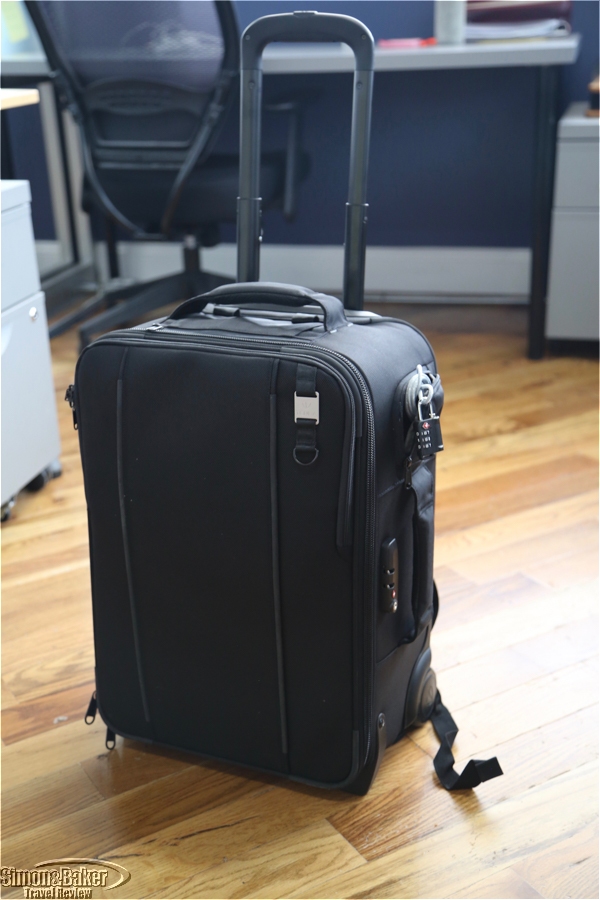
The Tenba 21 Hybrid Roller
I really wanted to love the Tenba 21 Hybrid Roller (Tenba, 75 Virginia Road, North White Plains, New York 10603, +1 914 347 3300, www.tenba.com, info@tenba.com). On paper it’s the perfect camera bag: a solid, versatile, roller bag that I can also throw on my back. On the road its performance was mixed. It was a terrific bag with a couple of small but maddening flaws that drove me a little nuts on a recent shoot.
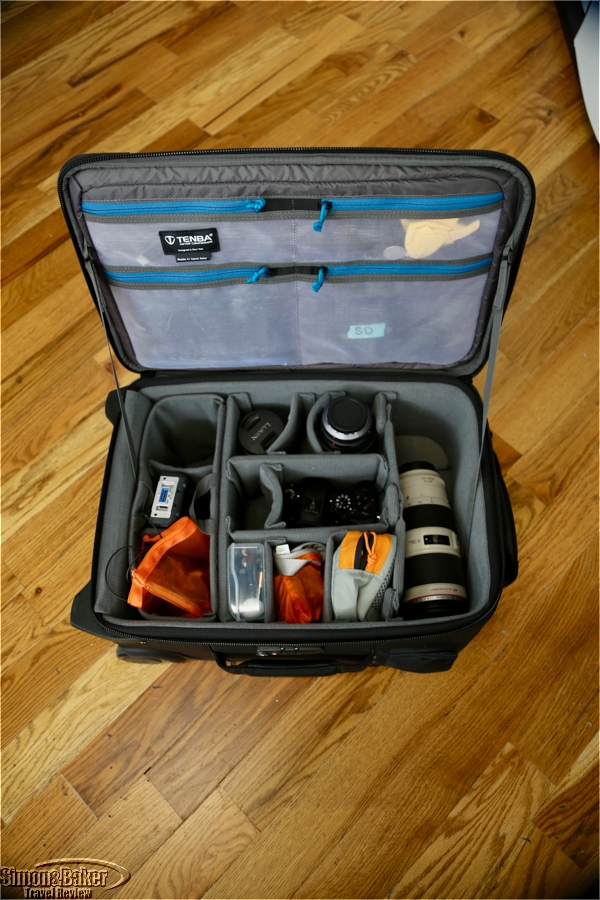
The Hybrid Roller offered a generous amount of storage space.
The Hybrid Roller, made in China, offered a generous amount of storage space, flexibility, and elegance. It had plenty of zippers and inner pockets, including a removable padded camera insert. It comfortably held everything I needed for a recent DSLR shoot, including my sound gear and a laptop. The interior dimensions of the bag were 12 wide by 17 tall by 7 deep, in inches. It had a handy drop-in tripod carrier which was a nice (and space-efficient) touch. If I wanted security, this bag had me covered with two built in locking mechanisms: a steel security cable and lock plus an integrated TSA (Transportation and Security Administration) approved zipper lock. Like other Tenba bags I have used, the roadie 21 was durable, weather resistant and a cut-above the competition in terms of luxury and style. I liked it for carry-on luggage.
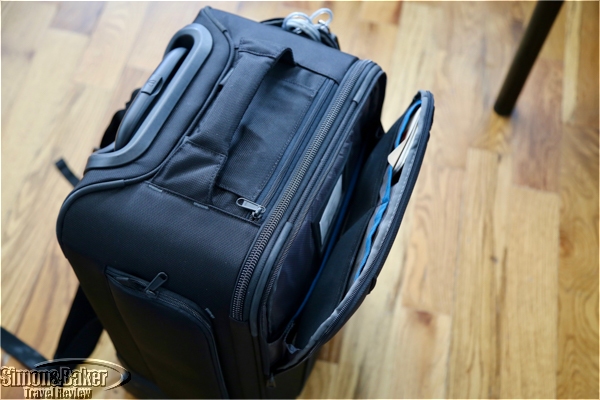
The Hybrid Roller single exterior pocket
As someone who likes to keep things organized I love pockets and compartments, so a minor gripe I had with this bag was the lack of an easily accessible exterior pockets (for a boarding pass, water bottle, kindle, snack, chargers). The Hybrid Roller only had only one exterior pocket, which made the bag look sleek and discrete, but limited its practicality for travel. While the exterior could have used more pockets, the interior delivered on that front and provided a safe home to my gear.
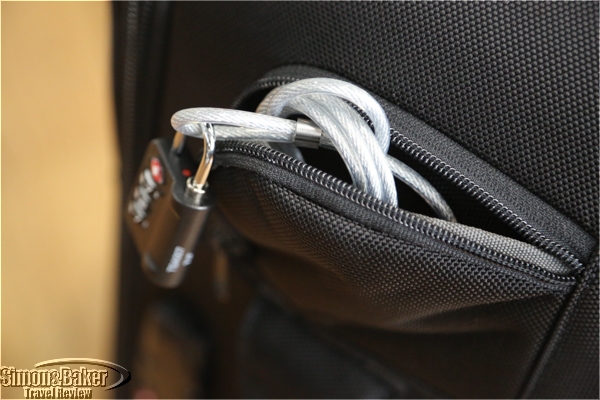
The built-in steel security cable and lock
However, the backpack part just didn’t cut it for me. The bag lacked the kind of padding and contours that are a natural feature in most bags designed to be backpacks I have used. When on my back it was uncomfortable and rigid, the straps felt thin, and the bag felt heavy and bulky (it weighed 11 pounds empty). It was my primary bag on a recent three day travel shoot from New York City to Utah and Idaho. By day two I was only using it as a roller bag.
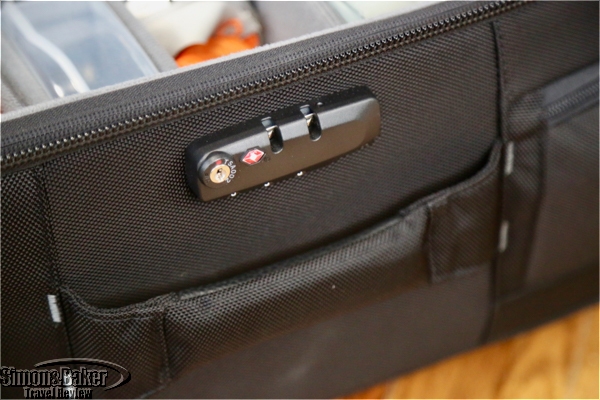
The integrated TSA approved zipper lock
I was hoping as a hybrid I could easily switch from backpack to roller bag, but when I had the backpack area opened, the straps would get caught in the wheels, ruining my flow (and the straps). Bottom line: to use it as a roller bag, I needed to first put away the backpack set-up (or cut the straps). For my colleagues who want a hybrid bag, and have the patience to withstand some discomfort and set-up, this bag packed a punch, but I recommend committing to the roadie 21 roller bag, not the hybrid version.
Our brief visit to Blyde River Canyon, South Africa
By Elena del Valle
Photos by Gary Cox
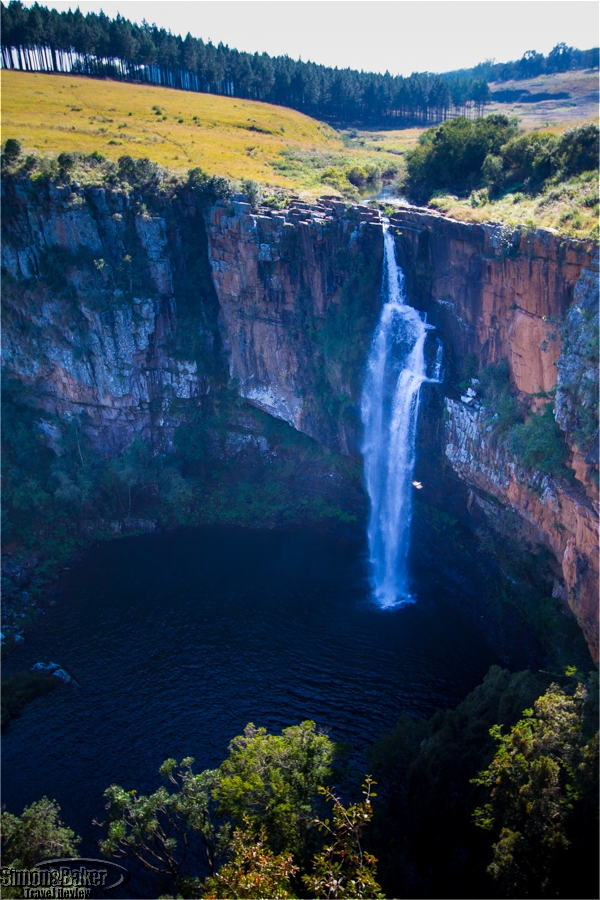
The Berlin Falls in Mpumalanga, South Africa
On a recent safari trip to South Africa earlier this year we had an opportunity to visit the Blyde River Canyon. One of the owners of the Belgrace Boutique Hotel, who also owned a tour company, invited us to a half day visit of the area as part of our transfer from his hotel to our safari property. Visiting the canyon required us to leave extra early. Our efforts were rewarded as the parking lot at the first of our stops was nearly deserted, except for curio vendors setting up for the day and staff cleaning the public bathrooms.
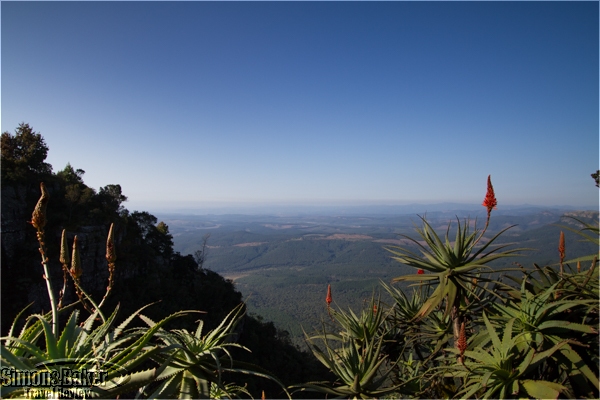
It was a little hazy, but the view from the God’s Windows lookout was breathtaking.
According to SouthAfrica.net, the 29,000 hectare Blyde River Canyon Nature Reserve is carved out of red sandstone and is one of South Africa’s most remarkable geological features. Salient areas of the “green canyon” we saw were the Three Rondavels or Three Sisters, God’s Window and Bourke’s Luck Potholes.
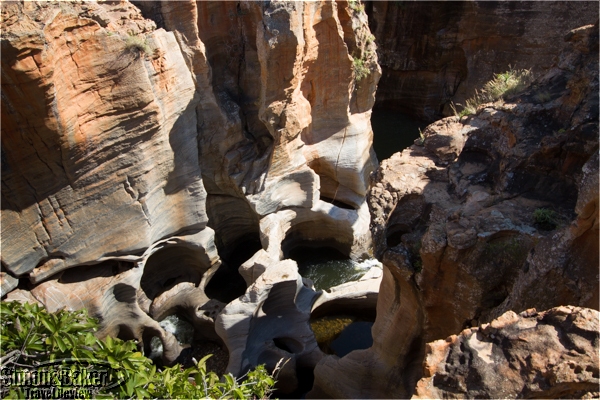
Over time the flow of water carved out circular “potholes” in the limestone of the valley.
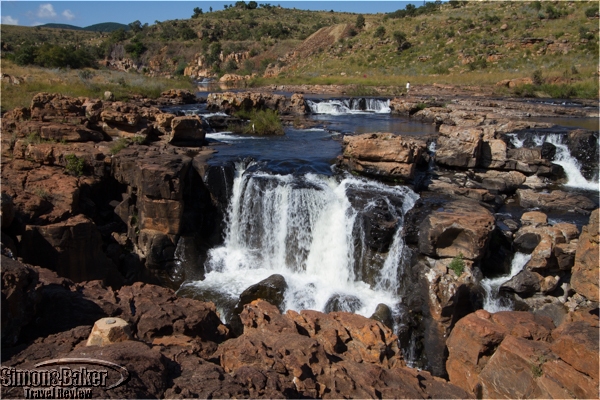
The river flows rapidly just above the potholes.
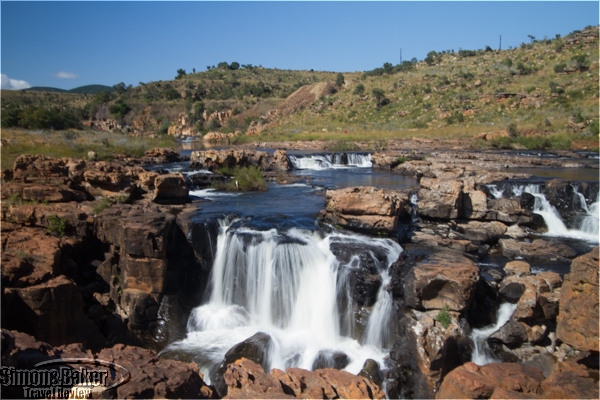
The same photo with a long exposure filter to smooth the water (just for fun)
The further along we progressed the more tourists we encountered, including several buses packed with travelers speaking foreign tongues. There were also more curio vendors in make shift structure and later inside a building. In lieu of lunch we snacked on locally produced cashews, macadamia nuts and dried fruits from a plastic container our tour escort brought with him. There were also chilled juices and water.

The Three Rondavels were our final stop as we made our way through the canyon.
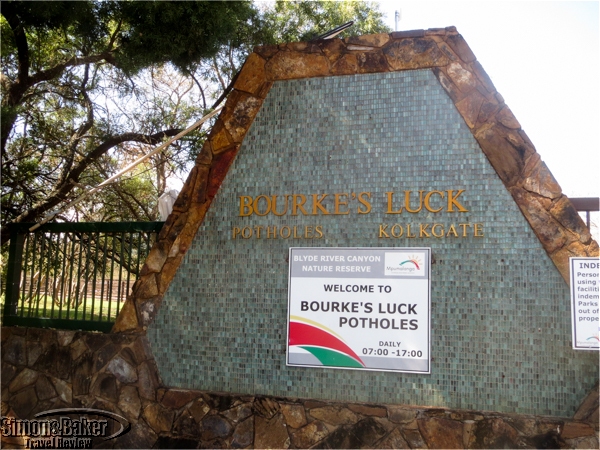
The series of attractions were part of the Blyde River Canyon Nature Reserve
The added attractions were worth the extra effort and time. Although we had few moments to spare for much beyond photos and quick rest stops we enjoyed the sights and the opportunity to see yet another beautiful natural wonder in the vast country full of natural treasures.
Camp Jabulani elephant experience
By Elena del Valle
Photos by Gary Cox
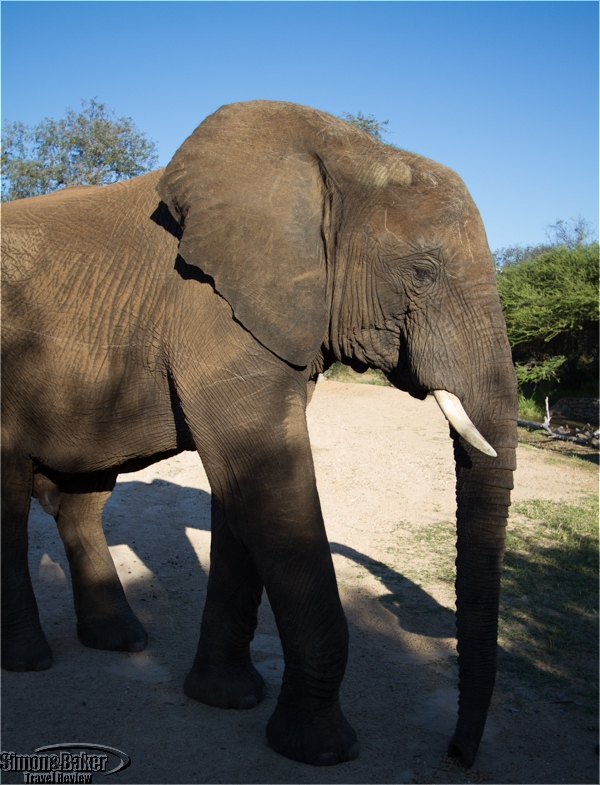
Jabulani, the camp’s namesake, at The First Meeting in May 2017
On our first visit to Camp Jabulani, a Five Star lodge near South Africa’s famed Kruger National Park, in 2008 we met some of the house elephants who had been raised or rescued by humans. After the young Jabulani, born in 1997, was abandoned by his elephant relatives when he became stuck in the mud the owners of the privately owned Big Five Kapama Reserve opened their hearts and their pockets to adopt him. In 2004, they established Camp Jabulani. When a herd of elephants in neighboring Zimbabwe was marked for slaughter they intervened, relocating the herd to their property.
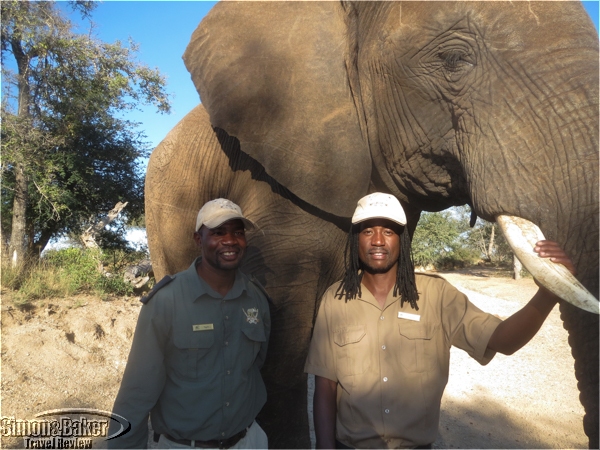
Left to right: Matipedza Tigere, elephant manager, and another staff member at The First Meeting, part of The Camp Jabulani Elephant Experience
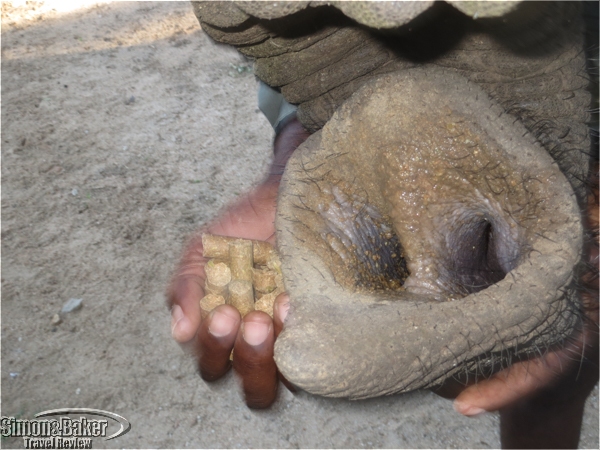
A staff member showed us how to feed the pachyderms pellets via the elephant’s trunk.
On that visit we met the whole herd, watched the staff tuck them in for the night and, most memorable of all, went elephant back riding. Earlier this year only weeks before our return, Camp Jabulani stopped offering elephant back rides. We wondered how the changes would affect our visit. We need not have worried as we had a comfortable stay and rewarding elephant experience at the luxury lodge.
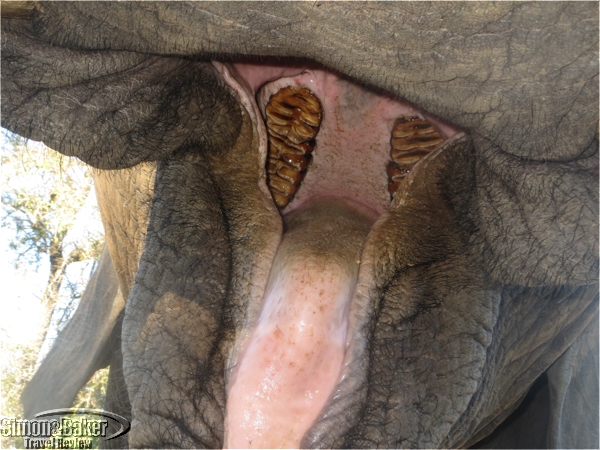
A closeup look at the elephant’s huge molars
“Camp Jabulani is a rather special lodge as it was established with the sole purpose of providing and income to look after Jabulani and a herd of elephants rescued from Zimbabwe in 2002,” Christo Rachmann, general manager, explained. “Currently the cost of looking after our elephants is around R450 000,00 per month. By visiting Camp Jabulani guests are actively contributing to the well-being of these magnificent animals.”
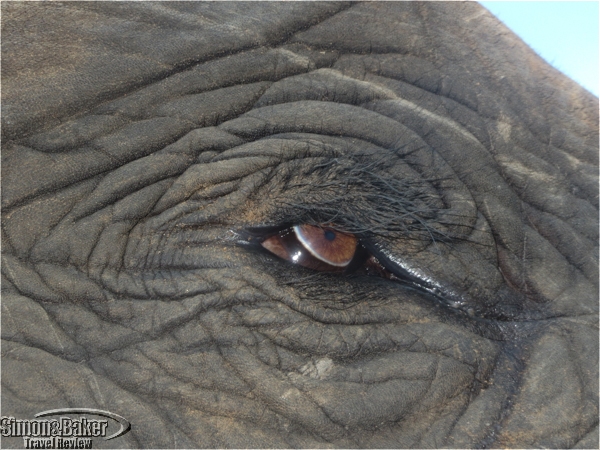
A closeup of the elephant’s huge eye and very long lashes was surprisingly difficult to photograph.
During our two night in stay in May 2017 we had The Camp Jabulani Elephant Experience. The day we arrived we had The First Meeting, part of The Camp Jabulani Elephant Experience. We spent a few minutes with Jabulani and another even larger young male. Under the watchful eye of Matipedza Tigere, elephant manager, we fed them pellet snacks, touched their skin and took photos. They smelled us with the tip of their trunk, quickly picked the pellets directly from our hands and let us run our hand along their side with surprising calm. Jabulani wrapped his trunk around my waist and dragged me gently yet firmly to one side (it was impossible to hold my position) until the elephant manager intervened.
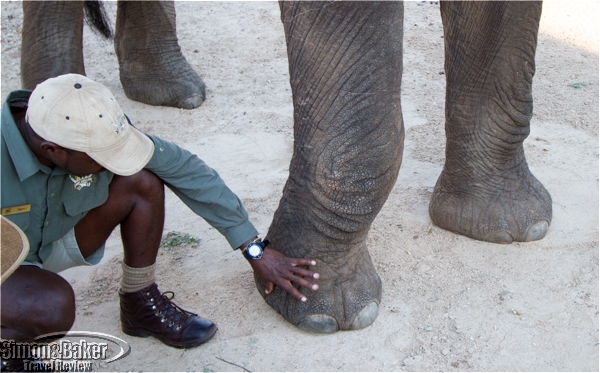
The elephant manager explained how an elephant’s foot carries its heavy body yet makes soft sounding footsteps.
Such nearness could give the false impression that elephants are easy to approach. Many safari trips have taught me that is far from true. I have a deep respect for the gentle giants. The elephants and the elephant manager’s relaxed demeanor reassured me as did his instructions. Tigere, a native of Chinhoyi, Zimbabwe, had 18 years of experience, and had a Field Guides Association of Southern Africa (FGASA) Level One Theory rating. He had been at Camp Jabulani since 2008. If he said it was safe to interact with the two huge creatures I believed him.
Because of the rescued elephants unique background the herd developed a positive atypical family structure. The staff explained that there are strong ties between male and female animals, and clearly established matriarchs have assumed responsibility for all infants, their own (five babies were born to the herd), as well as that of new orphans. The babies that have arrived in the last five years were successfully introduced to the herd with minimal human intervention. According to promotional materials, the managers and owners of Camp Jabulani planned to continue to rescue and rehabilitate elephants in need.
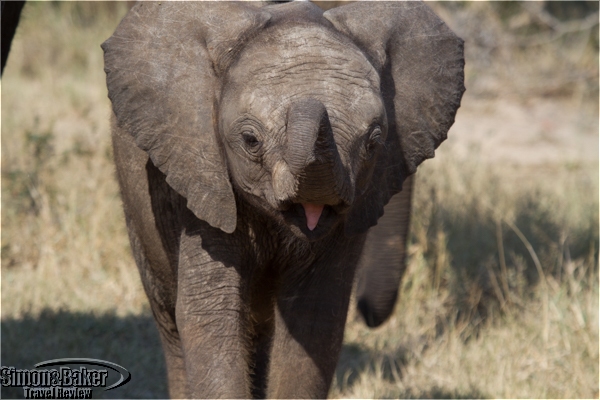
The youngest member of the herd was curious about our vehicle when we came to watch them play in the water
The following day at noon we waited for the 15 semi-tame elephants of the house herd to enter the water hole, hoping they would bathe. That was the In Their Element activity, also part of The Camp Jabulani Elephant Experience. We watched from our vehicle and they watched us back, curious. When playful elephants approached our vehicle our guide reversed, avoiding contact. A couple of times he revved the loud engine to make a particularly nosy elephant retreat. When we asked if there was danger he explained that wasn’t the case. They were curious about us and wanted to explore. The problem was that if an elephant brushed the new vehicle with its trunk it would damage the paint.
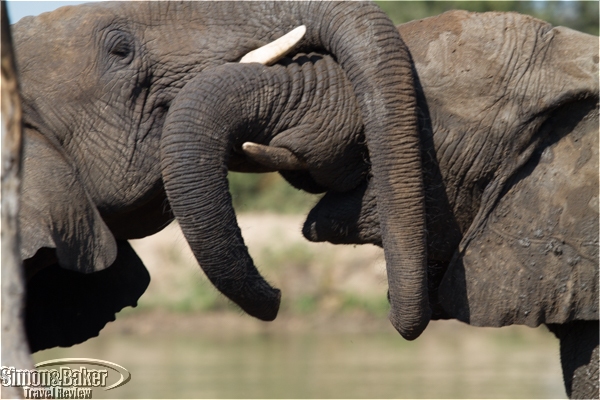
These younger members of the herd wrestled and played while we watched
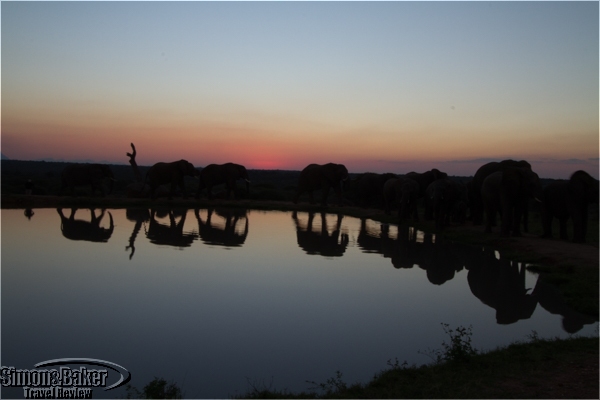
On the way to their pens for the night, the elephants paraded past our sun downer spot.
We watched the herd feed and interact. A number of elephant handlers sat around on the ground. We waved hello and they waived back. They called the youngest elephant to one side where they fed her a special extra nutritious blend from a bucket. For whatever reason the herd didn’t go in the water that afternoon. I didn’t mind much. Watching them so calm and playful was enough for me. A few minutes later the handlers rose to their feet, calling the herd away. As we drove back to Camp Jabulani I smiled. Our stay at the luxury property had been a pleasure, and seeing the elephants in close proximity the way we had was one of the main reasons.
At Sabi Sabi Bush Lodge excellent game viewing
By Elena del Valle
Photos by Gary Cox
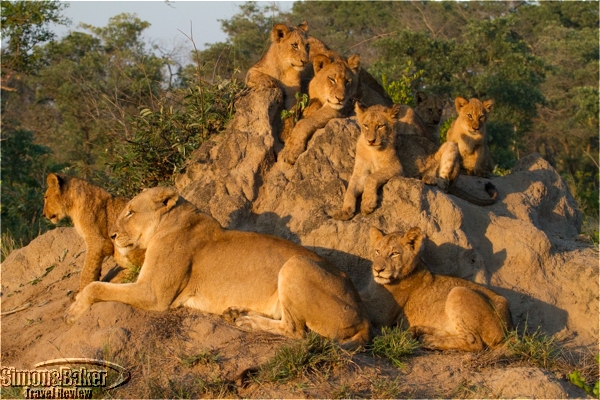
Watching the sun come up with the Southern Pride was one of the highlights of our trip.
On a recent safari trip to South Africa we stayed at Sabi Sabi Earth Lodge and Sabi Sabi Bush Lodge (Sabi Sabi Private Game Reserve, Sabi Sand Wildtuin, Mpumalanga, South Africa, lodge +27 13 7355-656, Sabi Sabi head office +27 11 447-7172, www.sabisabi.com, res@sabisabi.com). The two five star properties, members of the National Geographic Unique Lodges of the World, were family owned and located within the 6,000 hectare Sabi Sabi Private Game Reserve, which is within the Sabi Sand Reserve. It in turn is a Big Five reserve adjacent (without fences) to the famous Kruger National Park. At Bush Lodge we stayed in comfortable and spacious rooms, and we especially enjoyed the game viewing in a private vehicle and spa massage.

Our beds had color coordinated mosquito netting, a change from the customary white netting
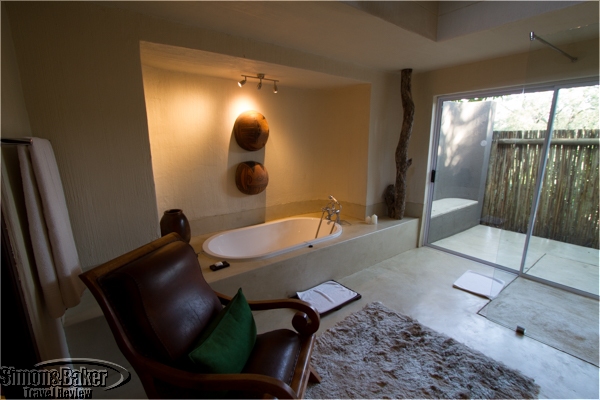
Our spacious bathrooms had a bathtub as well as indoor and outdoor showers.
During our visit, Stefan Schoeman, general manager lodges, Sabi Sabi, assisted us with camera related issues with speed and ease. We were glad to have our cameras in good working order since we saw the Big Five at Bush Lodge. On our first of two game drives we saw four of the Big Five. We drove around in an open Toyota LandCruiser in search of wildlife and interesting natural features to observe. We were delighted to have the game vehicle and Francois Rosslee, ranger, and Dollen Nkosi, tracker, to our selves. We have found that private game drives enhance our bush experience. So it was at Bush Lodge. Francois, a friendly man fond of his job, had been our ranger at Earth Lodge, where we had shared the vehicle with two other guests. That facilitated our arrival and check-in at its sister lodge.
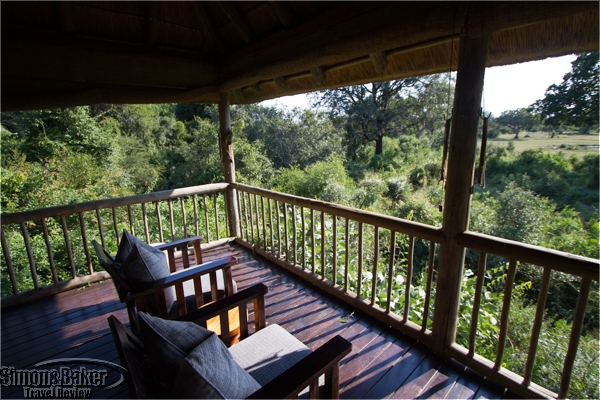
The main deck had several lookout points over the dry river
Francois was a Full Trails Guide Level 2 of the Field Guides Association of Southern Africa (FGASA) with six years of experience and a seemingly inexhaustible supply of energy. Dollen had attained a FGASA Tracker Level 2 and had been with Sabi Sabi for nine years.
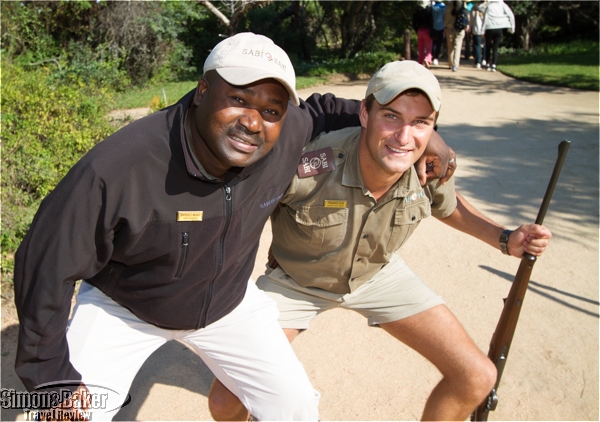
Our ranger Francois Rosslee (right) horsing around with Lawrence Mkansi, assistant lodge manager and head ranger
At Bush Lodge we saw the following mammals: buffalo, common duiker, dwarf mongoose, elephants, hippopotamus, kudu, leopard, lion, scrub hare, side-striped jackal, spotted hyena, tree squirrel, vervet monkey, warthog, waterbuck, white rhinoceros; insects: African monarch butterfly, Broad-bordered grass yellow, blue pansy, scarlet tip; trees and shrubs: jackalberry, knobthorn, leadwood, buffalo-thorn, silver cluster-leaf, large-leaved rock fig, greenthorn, and tamboti; and plants: wild cucumber, fannel weed, feather-top chloris, herringbone, and thatching yellow.
We saw or heard the following bird: African fish eagle, African grey hornbill, African scops-owl, bateleur eagle, Burchell’s starling, Cape glossy starling, Cape turtle dove, crested barbet, crested francolin, dark-capped bulbul, emerald-spotted wood-dove, fork-tailed drongo, go-away-bird, greater blue-eared glossy starling, green woodhoopoe, magpie shrike, rattling cisticola, redbilled oxpecker, southern yellow-billed hornbill, spotted thick-knee, Swainson’s spurfowl, laughing dove, Flappet lark.
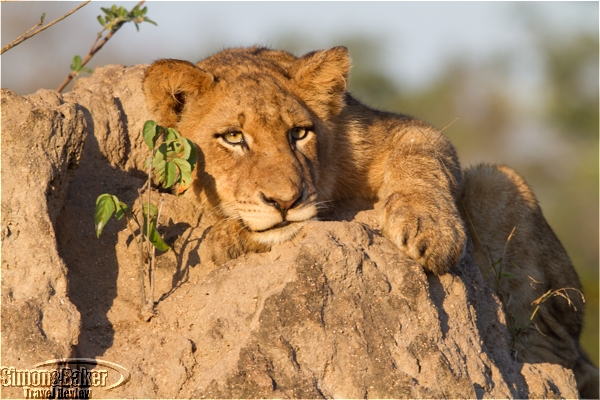
One of the lions
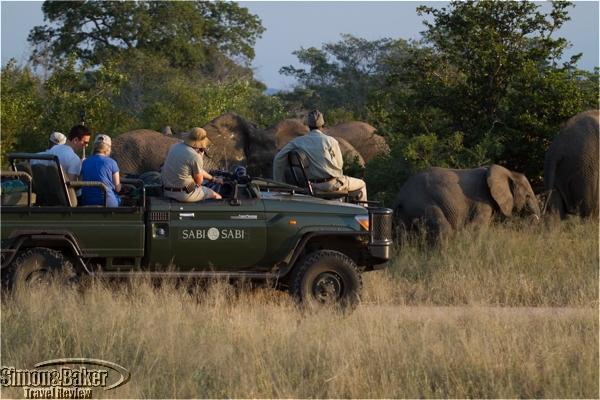
Approaching a sighting in progress
The 25 room family friendly property owned by Hilton and Jacqui Loon had two swimming pools, an amply stocked boutique shop (branded clothing, jewelry, coffee table books, art, accessories), Amani Health Spa, and EleFun Children’s Centre. Although the game reserve and lodge opened in 1979, during 2015 and 2016 the public areas and rooms were completely refurbished.

Our rooms had a sitting area, desk and small outdoor patio facing the dry riverbed.
Our 80 square meter well appointed Luxury Suites faced a dry riverbed. They were comfortably furnished (I especially appreciated the large pleasantly firm bed), quiet, cool when it was hot outside and warm when it was cold. Like its sister property it had a number of amenities such as coffee machine, mini refrigerator and perfume scented Charlotte Rhys toiletries as well as thoughtful touches like a convenient location for electric plugs on the desk and pre-stamped postcards.
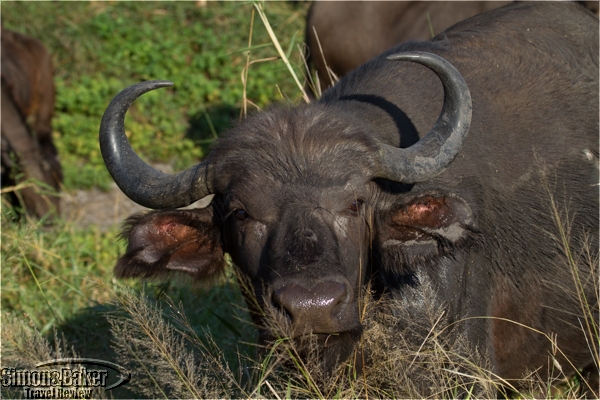
We had excellent closeup sightings of Cape buffalo, one of the Big Five.

A young kudu male with horns just developing

Stefan Schoeman, general manager, was a gracious host.
Meals were buffet style, with a made to order station, in an open air dining room in the main area. We sat at the table of our choice, where staff took our beverage orders. We enjoyed a delicious dinner, including Lamb neck, grilled meat and venison (gemsbock) in the boma (African open air enclosure).
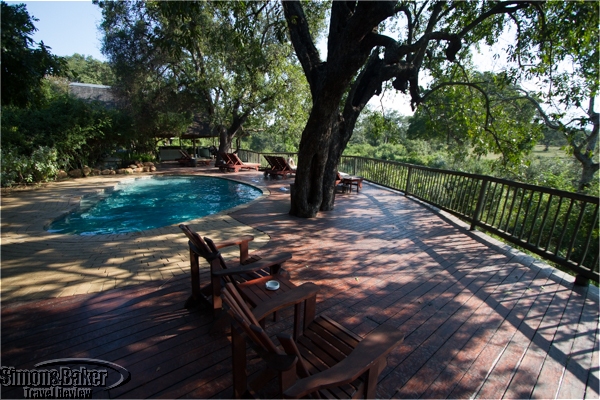
The pool deck had a view of the river
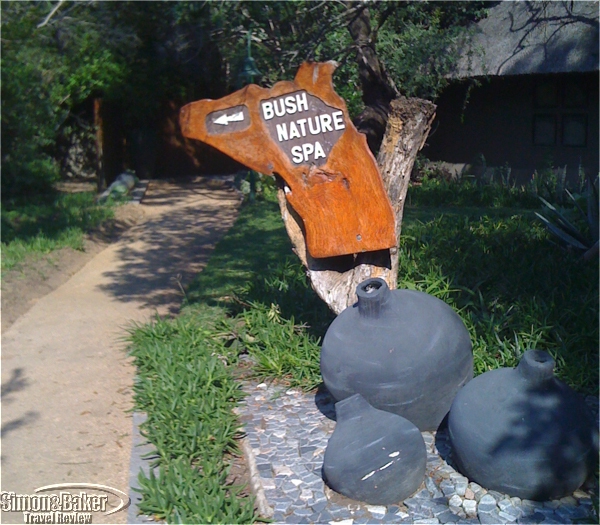
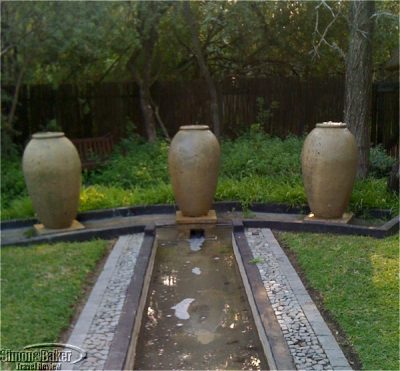
One of my favorite activities was a massage treatment with Tarren, the spa manager and Francois’s girlfriend. Had there been more time I would have explored the spa menu further. The excellent Big Five game viewing and spa treatment made our stay at Bush Lodge special. I would return and recommend it to friends seeking a family and group friendly stay in the Sabi Sand Reserve.
How I carried cameras safely on safari
Article and Photos by Gary Cox
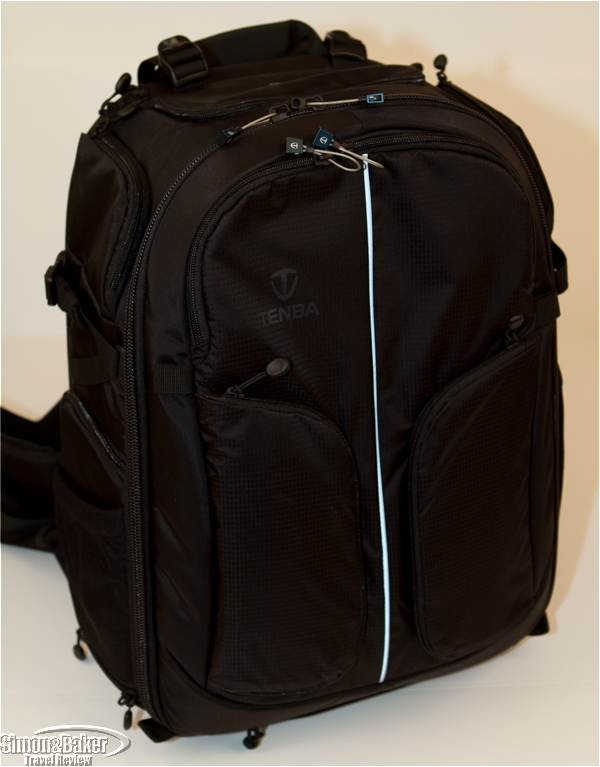
The Tenba Shootout Backpack 32L
Planning camera gear for an extended trip to Africa with location changes every two or three days starts with a solid transport solution. I don’t like anyone carrying my equipment, figuring that if someone is going to break stuff, it should be me. For my most recent trip, I chose the Tenba Shootout Backpack 32L (Tenba, 75 Virginia Road, North White Plains, New York 10603, +1 914 347 3300, www.tenba.com, info@tenba.com), and returned home happy with the decision and the performance of the bag. This is not a general purpose pack with some foam dividers stuffed into it, this is a backpack purpose built from the ground up for the photographer on the go.

My backpack has shoulder straps and a padded belt to distribute weight to the hips when worn.
The exterior of the backpack was made from water repellent twill and gray rip stop nylon. The interior compartments were built with rip stop nylon and soft tricot fabric, padded with perforated foam to minimize weight (six pounds empty). The center of the bag is for camera storage and featured water resistant pockets on the panel for storing memory cards and small items. It has full height pockets, one large on the front and one on the side for thin items. The other side has a half height pocket and an opening into the main chamber for quick access to a camera without unzipping the entire bag. There are some small organizing pockets on the front for miscellaneous items.
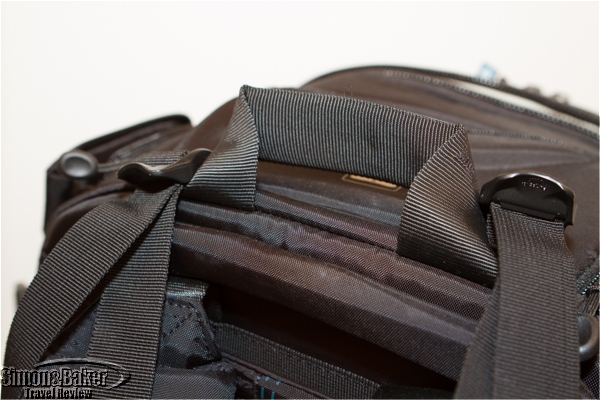
The padded handle allowed me to carry the load comfortably.
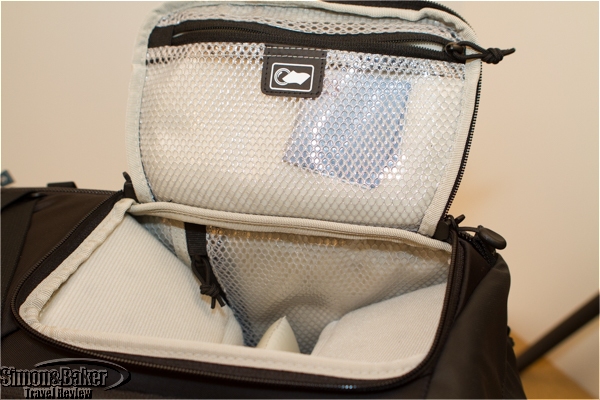
The side pocket gave me access to the main compartment and had a mesh pocket to store small items securely.
Near the handle on the top, there is a solid compartment to store fragile items. During the trip the compartment kept my sunglasses from being crushed. There is also a set of straps and a harness to attach a large tripod on the outside of the bag. A zippered compartment on the bottom holds a waterproof cover that can be pulled up over the bag like a little raincoat to keep it dry. Between the main compartment and the padded back brace and frame, there is a slot for a laptop or tablet. The zippers to the main compartment and front pocket can be locked with a small padlock, not included. The backpack, made in China, came with a small microfiber cloth and memory card wallet.
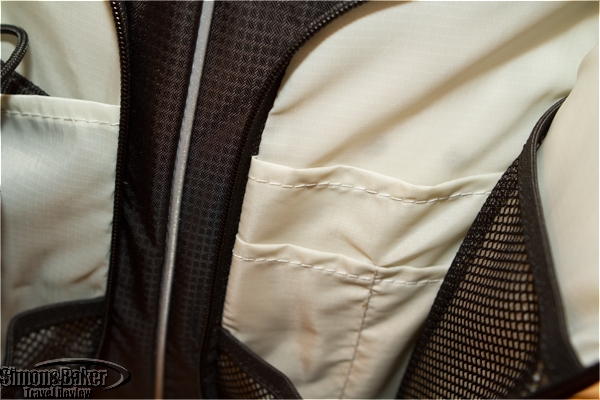
Opening the front pockets revealed more pockets for small items.
On safari trips to gather data on properties for the Simon and Baker Travel Review, I cannot afford to have any gear sidelined, so redundancy for key items is critical. On one trip, my wide angle lens bumped into the iron plating on the game viewing vehicle and broke. Apparently these are not in high demand for the average traveler in Botswana, and it was several days before I could get a replacement lens. I learned multiple lessons, pad everything during transfers and carry spares. The next challenge is the variety of shooting situations and the volume of photos I take. My go-to lens for general wildlife photography is the Canon 100 to 400 millimeter. It is versatile and a reasonable trade-off between weight and capability. On this trip, I included a 70 to 300 millimeter lens with the backup camera body.
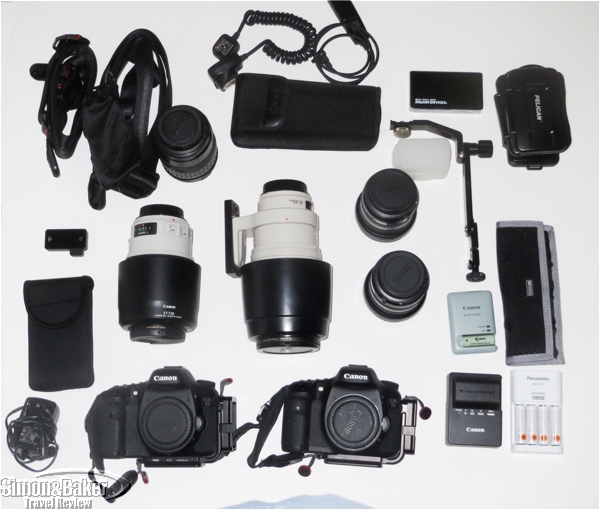
The camera equipment for our trip to Africa
I laid everything out before packing and started to wonder if the pack came in a larger size. Two camera bodies (Canon EOS 7D), two telephoto lenses, two wide angle lenses and a 28 to 130 millimeter for general purpose shooting. Flash, straps, batteries, chargers, memory cards, special purpose filters, macro adapter lens, cleaning supplies and iPad rounded out the final mix. It was a little tight, but everything fit and was well organized thanks to the bag’s dividers and pockets, including the handy well at the top for my sunglasses and mp3 player. With this load the backpack weighed over 30 pounds.
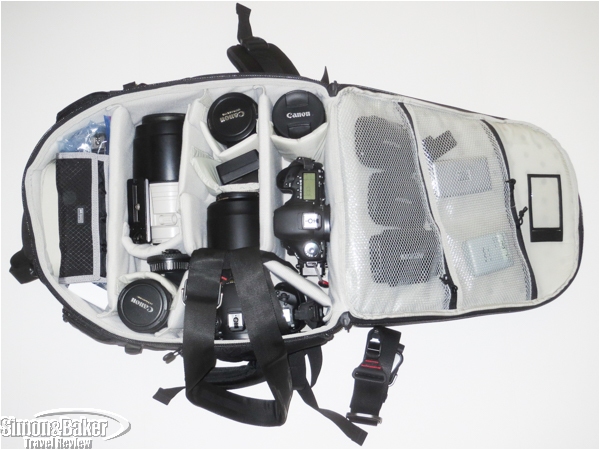
The main compartment held most of the camera gear
The fully loaded pack was comfortable to wear and distributed the weight across my shoulders and back. I am not a small guy and the straps had plenty of length, something I often find deficient in camera packs. The handle on the top of the bag was sturdy. The loaded pack rested upright and did not fall over when I set it on the ground. The padded belt could be a little annoying when I placed the bag into a cabinet or closet, but when I wore the backpack it was a godsend for balance and load distribution.
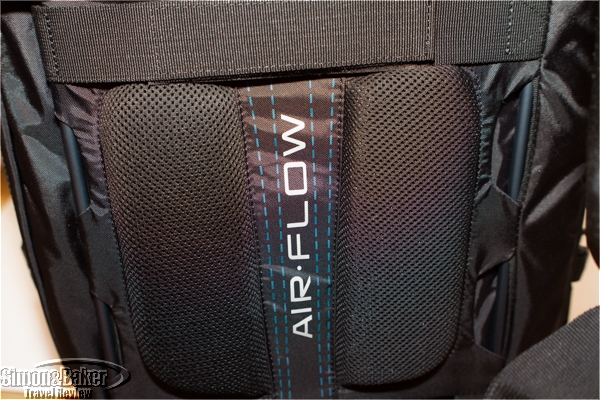
The Tenba Shootout Backpack 32L is padded and has a built in frame for stability.
The side of the bag has an easy access pocket to pull out a camera, but I never used that feature because my gear was too snug in the pack. I liked that the bag had lots of room for small things. It made it easy to keep organized. I used the pockets inside the main compartment for most of the memory cards and other valuable items. The outer pockets were handy for quick access, and ended up full of things I picked up when changing locations and then tidied away once we had rooms again. The tall side pocket was just right to hold my travel tripod. For the long haul flights I packed it away and only used the side pocket feature when changing properties in country. The zippers had nice easy to grab attachments and none of them became jammed or stuck.
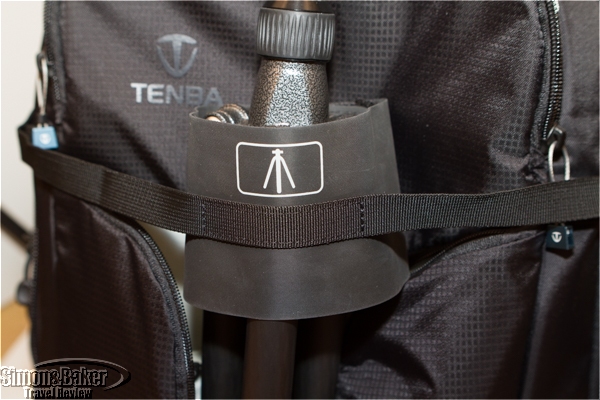
A strap allowed me to attach a tripod to the outside of the backpack.
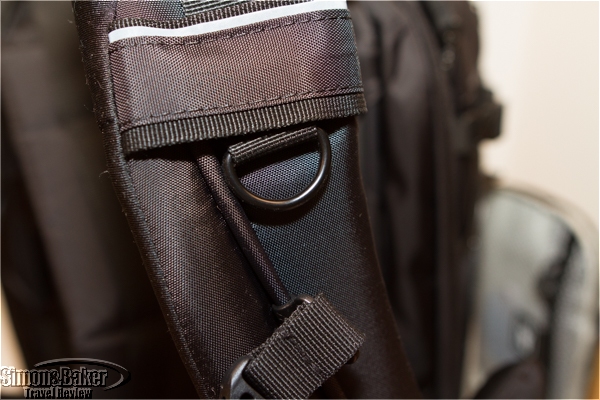
There were rings to attach external items on the shoulder straps
The bag held up well in extreme and varied conditions. For example, for the first 10 days we had intermittent rain and many opportunities to get muddy. The other three weeks were dry and dusty with a total of 12 property changes on planes, cars, vans and open safari vehicles. Everything inside my bag stayed safely clean and dry the entire time, and backpack arrived home looking new in spite of the opportunities to get muddy and dusty in the field. While pushing the luggage cart to the car in the parking lot at the airport at the end of the trip, the cart jammed solidly into a grating and the camera backpack flew off the top of the pile of bags landing on the parking lot surface. I assumed that a five foot forward flight and a four foot drop onto concrete would mean something was broken, but when I opened it at home, nothing was cracked or damaged. I would not recommend testing the backpack in that way, but it was good to know that when I let my guard down, the bag kept the contents unharmed. The Tenba Shootout Backpack 32L is my new choice for an expedition backpack to keep my gear safe.
Affordable luxury at The Berkeley Hotel in Richmond, Virginia
Article and photos by Scott S. Smith
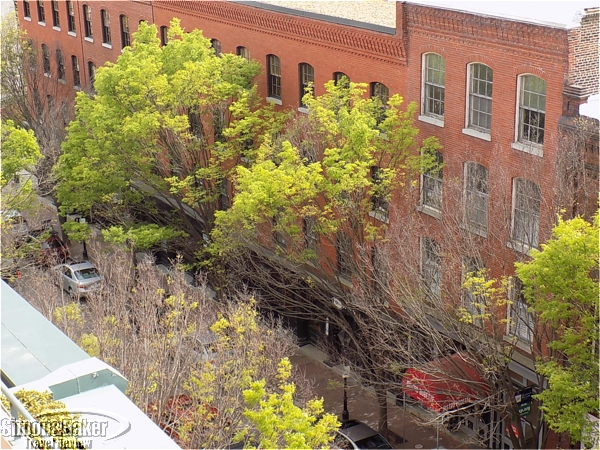
View from the top floor of The Berkeley Hotel in the restored tobacco warehouse district of downtown Richmond, Virginia
My bride, Sandra Wells, and I wanted to take our April 2017 honeymoon somewhere we could indulge our interest in history. We had never been to any of the sites related to the American Civil War and looked for the best place to learn more about that darkest of periods in our history. Atlanta had surprisingly little to offer, Gettysburg and most other battlefields were remote and focused just on local events, while we wanted to get a good overall understanding of the period. We came to realize that by far the best destination for this was Richmond, Virginia, around which dozens of battles were fought, since the capital of the Confederacy was just 109 miles south of Washington, D.C.
After consulting reviews and talking with experts in local tourism, we decided to spend two of our four nights at a 55-room luxury boutique hotel in the restored historic tobacco warehouse district in downtown Richmond, The Berkeley Hotel (1200 East Cary Street, Richmond, Virginia 23219, 804-780-1300, 888-780-4422, www.berkeleyhotel.com, info@berkeleyhotel.com). Downtown is just nine miles or 15 minutes from Richmond International Airport. It was built in 1988 by the Dobbs Family and prices were remarkably low for a four-star property (discounted because of ongoing renovation).
The Berkeley was set on the western edge of Shockoe Slip, whose cobblestone streets were a reminder that it was where the city started, and near the Central Business District. The hotel was an easy walk to the James River, where the American Civil War Center was located, and to the State Capitol, where the hemisphere’s oldest active legislature met (Richmond became the colonial capital in 1780; five years before, in a nearby church, Patrick Henry had given his speech with the famous phrase, “Give me liberty or give me death”).

The bed in our King Terrace View Room
The hotel assigned us a 300 square feet (27.8 square meters) King Terrace View Room on the top (sixth) floor. It had a balcony furnished with chairs to look out over the restaurants and stores that had breathed new life into the historic district. I’m not one to notice much about room décor, but there were lovely framed prints of flowers on the walls. We soon learned that many guests like to return to see how their new room is decorated because each was designed differently from all the others in carpeting, wallpaper, furniture, and even shape (there was a photo gallery on the website to compare some examples). The air conditioning and heat controls were easy to use and effective. The closet contained two terry cotton robes, an iron, and ironing board. There was a safe at the front desk.
The bed was very comfortable, with 100 percent Frette Italian linens, while the pillows were filled with down and feathers. The room was clean and we allowed cleaning once during our stay (it was normally once a day) and refused turn down service. We agreed to the hotel’s default policy of reducing impact on the environment by changing the linens every three days. Rollaway beds were available for an extra charge.
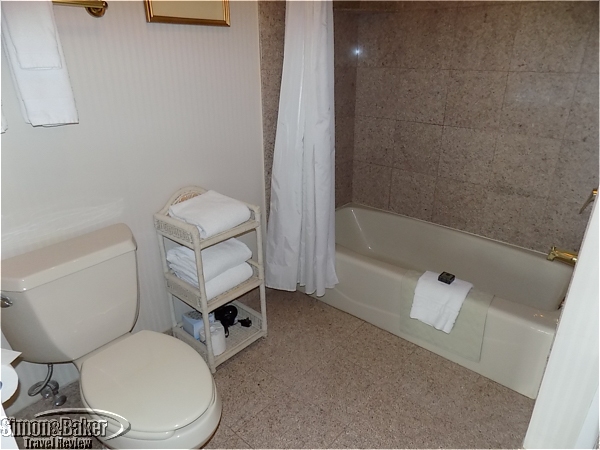
The bathroom in Room 604
There was a combination bathtub and shower with a powerful hydromassage showerhead. Like virtually every other luxury hotel we’ve been in, it had a makeup mirror with moderate (inadequate) lighting. There was a single sink, with toiletries from Gilchrist and Soames and cucumber and acai berry soap on the counter. The most unusual item was dental rinse (not something we normally have seen and helpful when dealing with flight liquid restrictions). There were two telephones, by the toilet and by the bed (local calls were free).
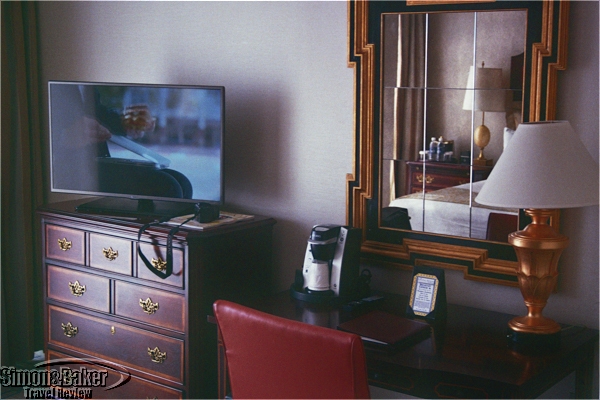
The desk and television side of the room
There was a coffee maker in the room, but we preferred to go to the lobby at 6:30 a.m. weekdays for fresh-made coffee, 7:00 a.m. on weekends (sweeteners included the best alternatives to sugar, stevia and erythiritol, which we have not seen often even in top hotels). There was also a desk and a 32-inch flat-screen LG television with cable. On the other side of the room there was a sitting area with stuffed chairs and a small round table.
There was complimentary high-speed wireless in the room and some public areas. There was no mini-bar or refrigerator, but ice machines were one floor below and elevators were fast (in a small hotel, that made transfers to other floors almost instantaneous). Complimentary health club privileges were available at the nearby Young Men’s Christian Association (YMCA). Children were welcome and the hotel was pet-friendly, charging $50 per stay, one per room up to 25 pounds.
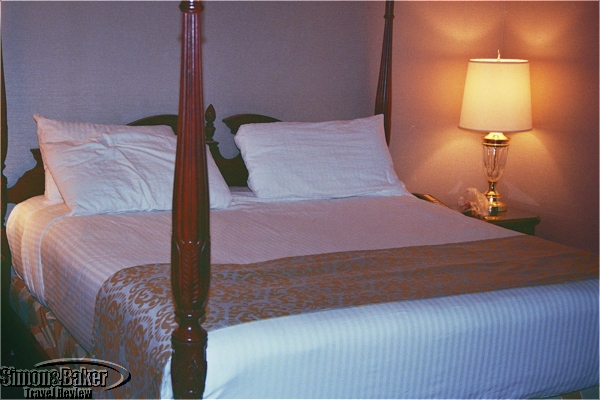
Our bed in the Governor’s Suite
Any hotel can create a nice environment with upscale carpets, décor, and furniture. Under normal circumstances, adequate training may produce good service. But a crisis highlights staff’s ability to balance conflicting demands from customers. On our first night at The Berkeley, we were asleep when around midnight we were awakened by a party next door. We asked them to keep it down, but when people get drunk they have a hard time judging whether they might be disturbing others. We finally called the front desk and within minutes a security representative invited us to move to Room 608 before he dealt with our neighbors. This seemed prudent: in our experience, most hotels prefer to start by asking guests to not disturb others, which usually just drags out the resolution. We had barely unpacked, so it was an easy move down the hall.
We were surprised when the new room turned out to be the Governor’s Suite, a pair of rooms behind a set of doors separating them from the rest of the top floor. The bedroom was 600 square feet (55.7 square meters) and had a 37 inch flat screen Philips television. Next to it was a Keurig coffee maker with Royal Cup and Green Mountain options. A three-panel full-length mirror stood in one corner. There were several sofa chairs around a low glass table and plenty of room for a small group to visit after a wedding (which is what the Suite was often used for, as well as for birthday celebrations and other special events; the adjacent room we just peeked into was for the reception or a dinner). The four-poster bed had two mattresses, which made for comfortable sleep. The Suite was rented the next night, so we returned to 604 in the morning.
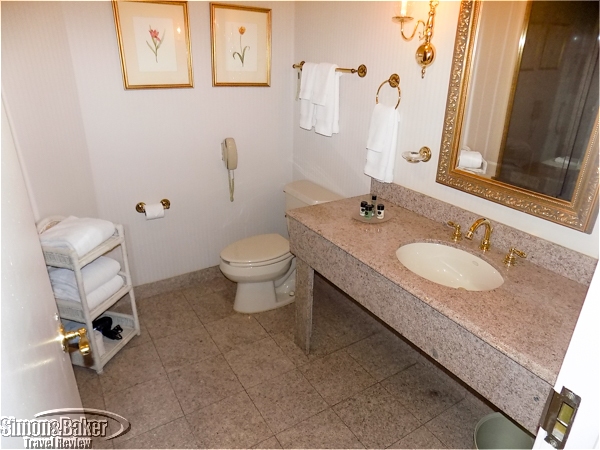

The bathroom in the Governor’s Suite
The bathroom in 608 was larger than 604, the single sink had more counter space, and the décor was nicer (large gold-trimmed mirror and lights). There was also a large walk-in shower, rather than the small tub-shower combo in 604.
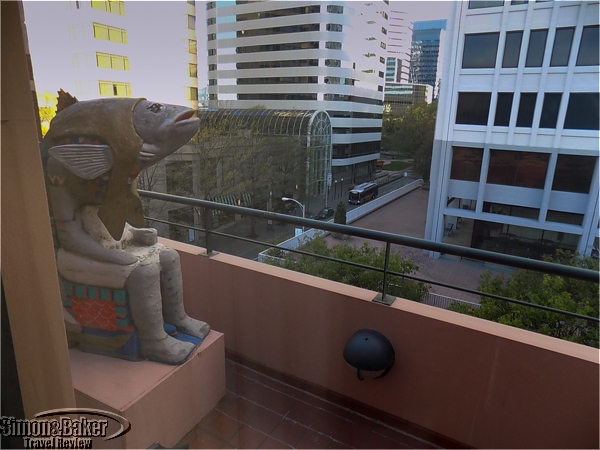
The view from the Governor’s Suite
There was a balcony with chairs outside 608 and a sculpture of a fish-headed, Egyptian-style god. The view was of the Central Business District.
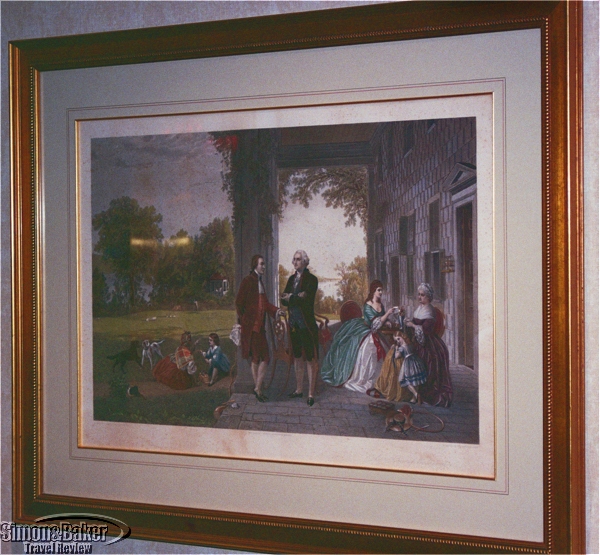
Artwork in one of the hotel hallways
The rooms and hallways were decorated with prints of paintings from the colonial era and old maps, which made it seem a place of Southern elegance from a bygone time. Many on the 60 staff of the hotel spoke Spanish. The ones we spoke with were knowledgeable about the city when we asked questions.
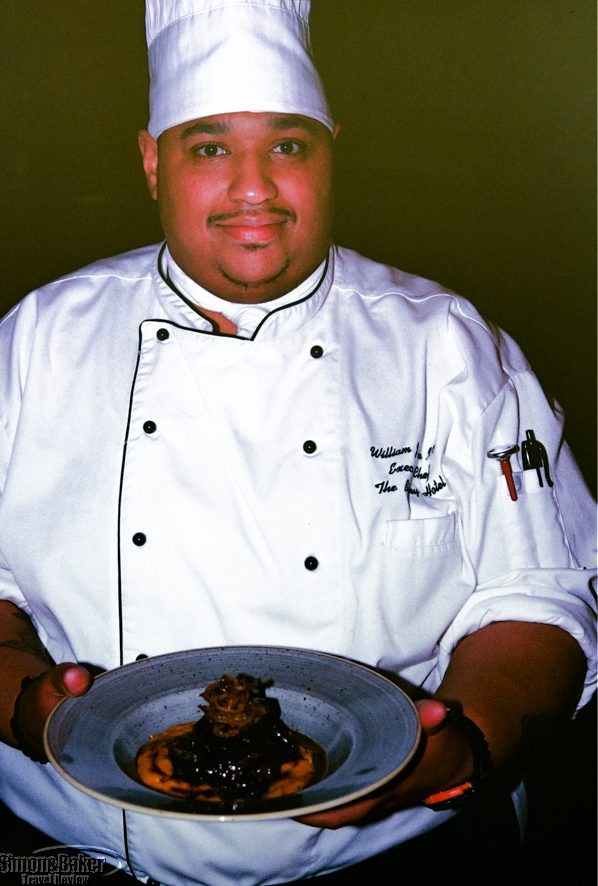
William Price III, chef, The Dining Room
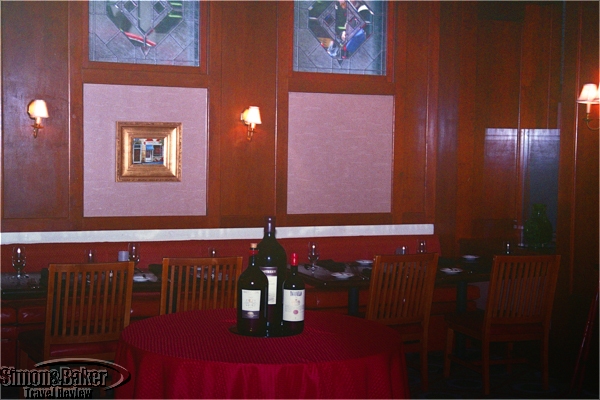
The Dining Room at The Berkeley
Breakfast, lunch, and dinner were served on the ground level in adjacent rooms, with a bar in the middle at the main restaurant, The Dining Room. William Price III, the young and friendly chef, had studied at the Pennsylvania School of Culinary Arts and Le Cordon Bleu Institute’s Pittsburg campus.
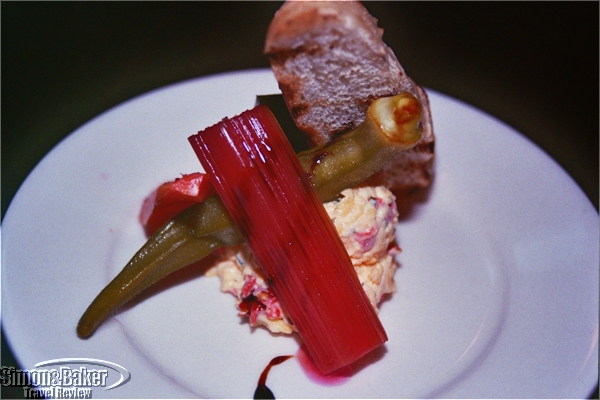
The Dining Room’s Amuse Bouche
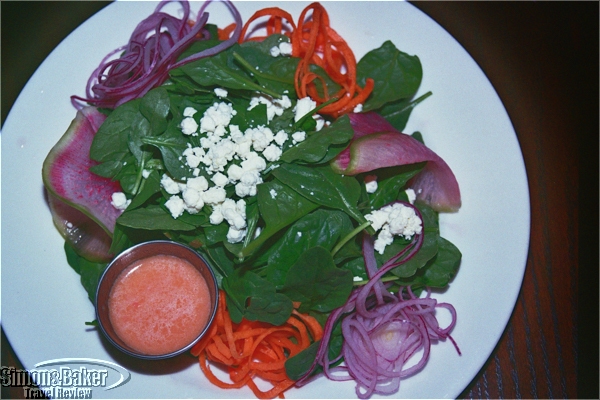
A salad at The Dining Room
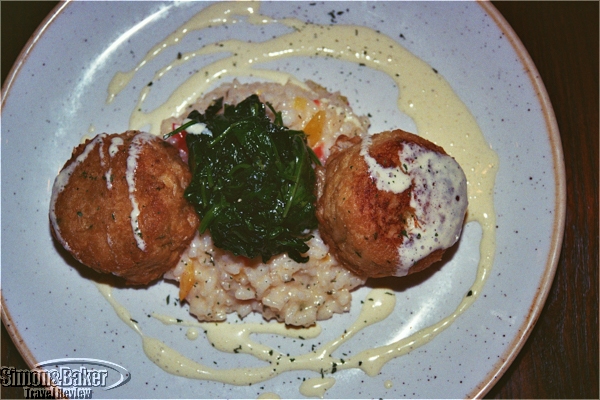
The chef’s Signature Southern dish
We enjoyed our breakfast, including the Signature Farmers Market Quiche, grits, a three-egg omelette with aged cheddar cheese, onions, and sautéed mushrooms, the Southern specialty fried green tomatoes, and a salad. There wasn’t a vegetarian option on the dinner menu. While Chef Price was whipping up a meatless experiment he had been working on, we amused our palettes with the Amuse Bouche, an appetizer of grilled French baguette, pimento cheese, and pickled vegetables, with sorghum balsamic vinaigrette, an apple peach crisp, and bread pudding. The chef’s Signature Southern, a tentative name, was a delicious concoction with five green tomatoes, Parmesan cheese, and sautéed spinach risotto.
We only had time to see the top priorities on our list in three days, including the Virginia Fine Arts Museum, the American Civil War Center, the Museum of the Confederacy, and the Black History Museum and Cultural Center (we also recommend the RVA Tour of the city over alternatives because of their extremely knowledgeable guides). Richmond was rich with culture, so we definitely want to return, and would stay at The Berkeley because of its location, comfortable beds, food, service, and price (we hope it remains a relative bargain when the renovation is complete).








